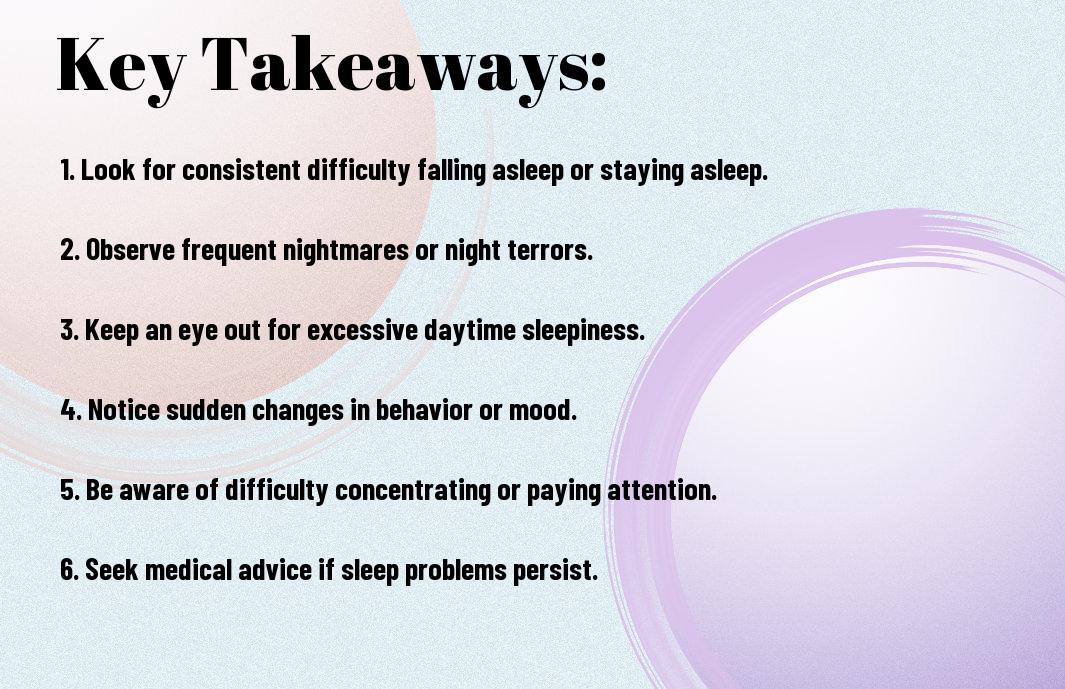As parents, it is paramount to be cognizant of the various sleep disorders that can affect children. The consequences of unaddressed sleep disorders can be severe and have a lasting impact on a child’s physical and emotional well-being. It is crucial for guardians to be able to identify the signs and symptoms of sleep disorders in their young ones, in order to address the issue and seek appropriate professional help. In this blog post, we will explore the common sleep disorders in children and what parents should be on the lookout for.
Key Takeaways:
- Early Identification: Parents should look out for signs of sleep disorders in their children, such as difficulty falling asleep, frequent waking during the night, or snoring regularly.
- Importance of Treatment: It is crucial for parents to seek medical help if they suspect their child has a sleep disorder, as untreated conditions can lead to learning difficulties and behavioral problems.
- Healthy Sleep Habits: Encouraging good sleep hygiene and establishing a bedtime routine can help prevent sleep disorders in children.
- Communication with the Child: Parents should talk to their child about any difficulties sleeping and create a supportive environment for discussing any concerns.
- Regular Check-ins: Monitoring a child’s sleep patterns and seeking professional guidance can help alleviate any sleep-related issues early on.

Types of Sleep Disorders in Children
Even at a young age, children can experience a range of sleep disorders that can impact their overall health and well-being. It is important for parents to be aware of the different types of sleep disorders that can affect their children. Below is a breakdown of the most common types of sleep disorders in children:
| Insomnia | Restless Legs Syndrome |
| Sleep Apnea | Narcolepsy |
| Parasomnias | Circadian Rhythm Sleep Disorders |
| Delayed Sleep Phase Disorder | Behavioral Insomnia of Childhood |
| Primary Snoring | Enuresis |
Insomnia in the Developing Brain
Types of insomnia in children can be diverse and may include difficulty falling asleep, staying asleep, or both. It can be caused by a variety of factors, including stress, anxiety, or certain medical conditions. The impact of insomnia on the developing brain can be significant, affecting cognitive function, mood, and overall well-being in children.
Parasomnias: Beyond Nightmares and Night Terrors
Beyond common nightmares and night terrors, parasomnias in children can encompass a range of disorders such as sleepwalking, sleep talking, teeth grinding, and rhythmic movement disorders. These parasomnias can disrupt restful sleep and may pose potential safety risks for children during the night.
Disorders such as sleep apnea and restless legs syndrome may also fall under the category of parasomnias, causing disruptions in children’s sleep patterns and affecting their overall well-being.
Sleep Apnea and Respiratory Considerations
The impact of sleep apnea and respiratory considerations on children can be quite significant. Snoring, pauses in breathing, and labored breathing during sleep are all signs that parents should watch for. Children with untreated sleep apnea may experience daytime fatigue, learning difficulties, and other negative health consequences.
With timely intervention and treatment, the symptoms of sleep apnea and respiratory considerations in children can be effectively managed, leading to improved sleep quality and overall well-being.
Recognizing the Signs
To determine if your children are suffering from sleep disorders, it is important to be aware of the signs and symptoms. By recognizing these indicators early on, parents can seek appropriate help and support for their children.
Behavioral Indicators of Sleep Disruption
Sleep disturbances can manifest in children through behavioral changes such as irritability, hyperactivity, and impulsivity. They may also exhibit difficulty in regulating emotions, leading to mood swings and tantrums. Additionally, disrupted sleep patterns can result in a decline in attention span and concentration.
Any significant changes in a child’s academic performance, memory, and decision-making capabilities could be indicative of sleep disruptions. These cognitive symptoms often result in decreased academic performance and behavioral problems in school. If left untreated, these issues can significantly impact a child’s overall development and well-being.
Symptoms such as frequent headaches, daytime fatigue, and persistent difficulty in concentrating during class may indicate an underlying sleep disorder. It is crucial for parents to remain vigilant and seek medical advice if they observe these signs in their children.
Approaches to Management
For parents seeking ways to manage sleep disorders in their children, there are several approaches that can be considered. These approaches range from environmental and behavioral interventions to medical and therapeutic options, all aimed at addressing the underlying causes of the sleep disorder and improving the overall well-being of the child.
Environmental and Behavioral Interventions
One approach to managing sleep disorders in children is through environmental and behavioral interventions. This may include creating a comfortable and soothing sleep environment by dimming the lights, maintaining a consistent bedtime routine, and limiting screen time before bedtime. Additionally, implementing behavioral strategies such as relaxation techniques and mindfulness exercises can help children with sleep disorders to calm their minds and bodies before bedtime.
On the other hand, in more severe cases, some children may require professional help in the form of cognitive behavioral therapy for insomnia (CBT-I). This approach involves working with a trained therapist to address the thoughts and behaviors that contribute to the child’s sleep disorder, ultimately helping them to develop healthier sleep habits and patterns.

Conclusion
Hence, it is crucial for parents to be vigilant and educated about the potential sleep disorders that may affect their children. By being aware of common symptoms such as frequent night waking, excessive daytime sleepiness, and difficulty falling asleep, parents can seek early intervention and treatment. Consulting with a pediatrician and creating healthy sleep routines can make a significant difference in addressing these issues and helping children get the rest they need for optimal growth and development. For more information on symptoms and treatments for sleep disorders in children, visit Sleep Disorders in Children: Symptoms and Treatments.
FAQ
Q: What are the common sleep disorders in children?
A: Common sleep disorders in children include insomnia, sleep apnea, parasomnias (such as sleepwalking and night terrors), and restless leg syndrome. It is important for parents to be aware of these conditions and seek medical advice if they suspect their child may be affected.
Q: How can parents recognize if their child has a sleep disorder?
A: Parents should look out for signs such as difficulty falling asleep, frequent night waking, snoring, restless sleep, and daytime drowsiness. It is also important to observe any unusual behaviors during sleep, such as sleepwalking or night terrors. Keeping a sleep diary can help track symptoms and assist in diagnosis.
Q: What should parents do if they suspect their child has a sleep disorder?
A: If parents suspect their child may have a sleep disorder, they should consult with a pediatrician or a sleep specialist. It is important to address sleep issues early, as sleep disorders can affect a child’s development, behavior, and overall well-being. Treatment options may include lifestyle changes, behavioral therapy, or medical intervention, depending on the specific disorder.
